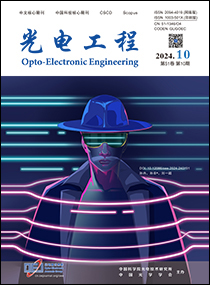2024 Vol. 51, No. 10
Cover story: Sun R, Sun F, Liu Y C. Research progress and development trend of electromagnetic cloaking[J]. Opto-Electron Eng, 2024, 51(10): 240191
Cloaking, a scientific fantasy since ancient times. The proposal of transformation optics (TO) theory in 2006, based on the method of coordinate transformation, has theoretically achieved perfect invisibility by designing a special distribution of electromagnetic materials. With the continuous deepening of research, cloaks have achieved a series of breakthroughs from theoretical models to laboratory prototypes, and then to invisibility materials close to practical applications. Research in this field spans multiple disciplines such as physics, optics, and material science, and is closely related to military, security, medical, and other fields, showing great potential for application and development.
The research team led by Associate Researcher Fei Sun review the differences and connections between full-space cloak and carpet cloak, focusing on two main mechanisms for achieving full-space cloak: light-bypassing cloak and scatter-cancelling cloak. Since the introduction of TO theory in 2006, the research on light-bypassing cloaks has become a hot topic in the scientific community. Research on scatter-cancelling cloak focuses on how to design special materials or structures to cancel the scattering field of the hidden object with the scattering field produced by the cloak, thereby achieving invisibility to external electromagnetic waves. Optimization algorithms provide a new method for designing cloaks, enabling optimal invisibility effects within given material ranges while improving design efficiency and innovation.
The review outlines the future development trends of electromagnetic cloaks, with main research branches including multi-physical field cloaking, broadband cloaking technology, intelligent adjustable cloaking technology, and artificial intelligence algorithms.

-
{{article.year}}, {{article.volume}}({{article.issue}}): {{article.fpage | processPage:article.lpage:6}}. doi: {{article.doi}}{{article.articleStateNameEn}}, Published online {{article.preferredDate | date:'dd MMMM yyyy'}}, doi: {{article.doi}}{{article.articleStateNameEn}}, Accepted Date {{article.acceptedDate | date:'dd MMMM yyyy'}}CSTR: {{article.cstr}}
-
{{article.year}}, {{article.volume}}({{article.issue}}): {{article.fpage | processPage:article.lpage:6}}. doi: {{article.doi}}{{article.articleStateNameEn}}, Published online {{article.preferredDate | date:'dd MMMM yyyy'}}, doi: {{article.doi}}{{article.articleStateNameEn}}, Accepted Date {{article.acceptedDate | date:'dd MMMM yyyy'}}CSTR: {{article.cstr}}

 E-mail Alert
E-mail Alert RSS
RSS


